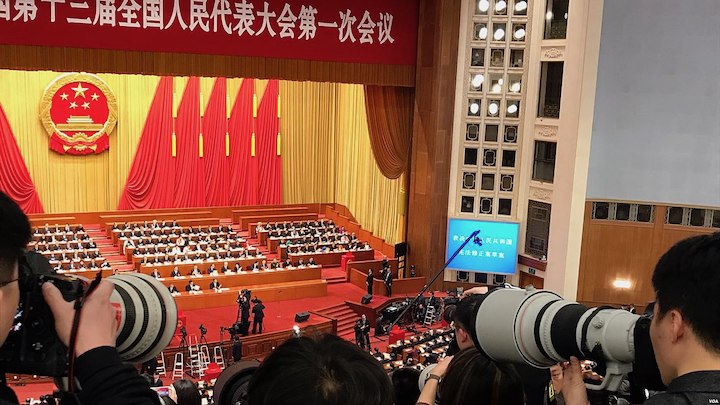Beijing Announces National Security Legislation Targeting Hong Kong
China proposes a restrictive new law giving the CCP greater control over Hong Kong, and changes tack to support an investigation into the coronavirus’s origins. Meanwhile, the United States further restricts sales to Huawei, and TSMC plans a new semiconductor plant in Arizona.

Published by The Lawfare Institute
in Cooperation With

Beijing Announces National Security Legislation Targeting Hong Kong
China announced on May 21 that the National People’s Congress (NPC) would pass legislation giving the Chinese Communist Party (CCP) greater control over Hong Kong. On May 22, the NPC introduced legislation that would “prevent, stop, and punish” activities endangering national security in Hong Kong, and allow Beijing to “set up agencies in Hong Kong” to carry out these duties. Critics worry the measures will enable the CCP to clamp down on the freedoms Hong Kong has traditionally enjoyed under the “one country, two systems” governance model.
The NPC appears to be considering passing the legislation without formal support from Hong Kong’s elected officials. Analysts note that China could bypass Hong Kong’s legislature by adding the new law into Annex III of Hong Kong’s Basic Law, the mini-constitution that governs the city and clarifies its relationship to Beijing. The Basic Law provides that, with the exception of laws in Annex III—a section that currently includes laws on national holidays, diplomatic immunity and other formal matters of state—laws passed in Beijing will not apply to Hong Kong. And Article 18 of the Basic Law specifies that Beijing ought to consult Hong Kong government officials before making amendments to Annex III.
But in practice, it’s not clear that Beijing would need approval from the government in Hong Kong before adding new national security legislation to Annex III. Beijing may use this strategy to avoid invoking Article 23 of the Basic Law, which requires the government of Hong Kong to pass legislation aimed at preventing “treason, secession, sedition,” and “subversion” of the Chinese government. Beijing invoked Article 23 to require the government of Hong Kong to pass anti-sedition legislation in 2003, but the plan was shelved when it met with mass protests in Hong Kong.
The NPC announcement comes as tensions between Beijing and pro-democracy political groups have run high. A session in Hong Kong’s Legislative Council turned into a brawl on May 18, as pro-democracy legislators and pro-Beijing legislators found themselves in a dispute over who should run the legislature’s powerful house committee. The previous week, the Legislative Council’s president appointed Chan Kin-por, a pro-Beijing lawmaker, to preside over the election of a new leader for the house committee, which examines legislation and decides which bills will come to a vote. At the May 18 session, Mr. Chan was surrounded by guards at the chairman’s seat in the council. When pro-democracy lawmakers tried to reach the seat, they clashed with guards, who in some cases carried them out of the building.
Some analysts have argued that Beijing is working to suppress Hong Kong’s pro-democracy movement under the cover of the coronavirus. Beijing has arrested democracy advocates, declared that it can intervene in areas of Hong Kong’s governance traditionally reserved to the city and used public health regulations as justification to clamp down on protestors.
President Xi Agrees to Support an Independent Investigation Into the Coronavirus’s Origins at WHO Meeting
On May 18 and 19, the World Health Assembly—the decision-making council for the World Health Organization (WHO)—convened virtually for the first time since the coronavirus crisis began. The assembly came amid growing calls for an independent investigation into the origins and spread of the virus, criticism from the United States about the role of the WHO in China’s mishandling of the pandemic, and controversy over China’s pressure campaign to keep Taiwan out of the WHO. At the convening, the World Health Assembly unanimously passed an EU-backed resolution calling for an independent investigation into the origins of the coronavirus and the world’s subsequent response to contain it.
In the weeks leading up to the meeting, the Australian government had repeatedly called for a series of measures that would shed light on the origins of the coronavirus and its rapid transmission. In April, Australian foreign minister Marise Payne recommended the establishment of an international tribunal with powers similar to U.N. weapons inspectors to investigate the origins of the coronavirus. Canberra also urged G-20 nations to end wildlife trading on the grounds that the practice could increase the risk of a future pandemic. In an apparent response to Australia’s comments, China announced new tariffs and restrictions on Australian imports, including barley and beef. Hu Xijin, editor of the Chinese Communist Party-mouthpiece Global Times, referred to Australia as “gum stuck to China’s shoe” in light of Canberra’s calls for investigations.
But as momentum for an independent investigation grew, China changed tack. On Monday, in a speech before the World Health Assembly, President Xi Jinping defended China’s response to the pandemic but said that Beijing would support a “comprehensive” WHO-led review into the global response to the pandemic once the virus has been controlled. China then added its name as a sponsor of the resolution calling for an independent investigation just before it came to a vote. In his speech, Xi also promised $2 billion over the next two years to help other countries combat the coronavirus. He said the money would “help with Covid-19 response, and with economic and social development in affected countries, especially developing countries.” Xi noted further that, if a vaccine becomes available in China, it will be made “a global public good.”
The United States has continued to criticize both the WHO and China for aspects of their response to the coronavirus. Alex Azar, secretary of health and human services, told the World Health Assembly that “We must be frank about one of the primary reasons this outbreak spun out of control: There was a failure by this organization to obtain the information that the world needed. And that failure cost many lives.” In an apparent reference to China, Azar added that “one member state made a mockery of their transparency obligations, with tremendous costs for the entire world.” Meanwhile, President Trump sent a letter to WHO Director-General Tedros Ghebreyesus threatening to permanently cut U.S. funding for the organization. Trump wrote that “the only way forward for the World Health Organization is if it can actually demonstrate independence from China.” The president’s letter follows his decision in April to halt U.S. funding for the WHO, pending a U.S. review of the organization’s “role in severely mismanaging … the spread of coronavirus.”
One absence at the World Health Assembly was especially notable: that of Taiwan. In the days before the assembly convened, the United States and 15 other countries had called on the WHO to invite Taiwan to join the proceedings. But on May 18, Taiwan’s foreign minister, Joseph Wu, said that the WHO had not extended an invitation because it had “yielded to pressure from the Chinese government.” In a statement, U.S. Secretary of State Mike Pompeo condemned Taiwan’s exclusion from the assembly, saying that the WHO’s decision “deprives the Assembly of Taiwan’s renowned scientific expertise on pandemic disease, and further damages the WHO’s credibility and effectiveness at a time when the world needs it the most.”
U.S. Restricts Foreign Sales to Huawei, as TSMC Announces U.S. Plant
On May 15, the U.S. Commerce Department announced a new rule that will block Huawei from purchasing certain semiconductor chips built with U.S.-made software. The rule specifically covers semiconductors that are made according to Huawei’s product-design specifications, regardless of their location of manufacture. The new rule is the latest in a series of U.S. measures aimed at restricting Huawei’s purchases of American technology, which began when the Trump administration placed Huawei on a partially implemented export ban list in May 2019. Senior U.S. officials had coalesced around implementing this type of measure in March; the Commerce Department, however, had until last week stalled its implementation indefinitely.
The Commerce Department intends the measure to close a loophole in the existing ban on sales to Huawei. Producers, to date, have been able to sell Huawei semiconductors manufactured largely outside the United States, even if their chip production relies on U.S.-made software. The new rule changes this, and it therefore serves to cut off Huawei’s access to major chip suppliers, like Taiwan Semiconductor Manufacturing Company (TSMC), that had continued selling to it under the blacklist. Analysts have noted, however, that the new regulation still leaves “potential gaps that are exploitable.” Companies may be able to sell Huawei goods through third-party distributors, for instance, if they cannot be proven to know that Huawei is the final destination for their products. And in theory, the rule leaves unaffected sales to Huawei of chips made outside the U.S. that are not tailored to Huawei’s specifications.
Accompanying this news, TSMC last week announced its intention to build a semiconductor manufacturing location in Arizona. The Arizona plant, which is scheduled to begin production by 2024, will be TSMC’s second in the United States; it already has one in Washington state, as well as design centers in Texas and California. The plant’s capacity will be “relatively small” compared to TSMC’s total production, most of which takes place in Taiwan. However, both TSMC and the Trump administration have emphasized the move’s geopolitical significance. TSMC stated that “[t]his project is of critical, strategic importance to a vibrant and competitive U.S. semiconductor ecosystem.” Recently, senior Trump administration officials have argued that the United States has only a few years to boost its production of technologies like semiconductors in order to avoid ceding long-term dominance in this area to China.
Commentators have observed that the Arizona plant announcement signals “warming relations” and “good will” between TSMC and Washington. All this may portend a strategic shift at TSMC—which had previously lobbied Washington not to tighten Huawei export restrictions—away from supplying chips to China and toward closer ties with the United States. In recent months, Trump administration pressure on TSMC to “choose” between the United States and China has been rising, which may have affected the company’s decision-making. Other analysts, however, have taken a more skeptical view of the announcement. Some have expressed doubt that TSMC will move any meaningful production to the United States, contending that the announcement is merely intended to appease the Trump administration. Others have noted that the factory’s construction will be costly, which may make it infeasible without significant U.S. government support.
These two developments represent setbacks for Huawei as well as China’s broader technological and geopolitical ambitions. Analysts widely believe that the Commerce Department rule will put serious financial strain on Huawei, as Chinese domestic suppliers cannot easily replace imports covered by the ban. Huawei’s chairman Guo Ping on May 18 acknowledged the gravity of the new rule, commenting that Huawei’s main focus was now “survival”—though he expressed confidence in the company’s prospects overall. (Huawei’s current stocks of core components are, reportedly, enough to last about six months.) Commentators have also stressed that TSMC’s movement toward the U.S. threatens Chinese leverage over Taiwan—a region it claims as its own territory.
Huawei and Chinese government officials have already strongly condemned the Commerce Department rule. Huawei—which has long argued that the U.S. blacklist against it is groundless—criticized the U.S. measures as “arbitrary and pernicious.” The Chinese state-run paper Global Times wrote on May 15 that China stands ready to respond to the rule with “a series of countermeasures.” Such measures, it suggested, could include banning imports from U.S. tech companies, investigating or imposing regulations on them or halting other U.S. imports, like Boeing products. Likewise, China’s Ministry of Commerce wrote that China would respond to the Commerce Department rule with “all necessary measures.”
These developments, commentators have argued, will also spur China to invest more heavily in its domestic semiconductor manufacturing. On May 15, China’s largest state-owned semiconductor manufacturer, Semiconductor Manufacturing International Corporation (SMIC), announced that it had received more than $2 billion in new investments from Chinese state-owned semiconductor investment funds. With technology-related tensions rising between the U.S. and China over the past year, Huawei already began redirecting semiconductor purchases away from TSMC and toward SMIC late last year.
Other News
The Trump administration has imposed new visa restrictions on Chinese journalists. On May 11, the Department of Homeland Security issued a new regulation limiting Chinese journalists to 90-day visas, rather than the open-ended, single-entry visas that Chinese journalists previously received. The regulation is the latest escalation of a clash between the United States and China over the work of journalists in each other’s countries. Earlier this year, the United States required Chinese media outlets affiliated with the Chinese government to register as foreign agents, and set new caps on the number of journalists they could employ. The new caps effectively required the organizations to send some employees back to China. In response, China expelled U.S. journalists from major outlets, including the Wall Street Journal, the New York Times and the Washington Post. China has threatened to retaliate for the recent visa restrictions.
Provinces in China’s Northeast have reentered lockdown, after China’s reopening in the region created a second outbreak of coronavirus cases. In total, some 100 million people live in areas affected by the new lockdown, where cities have required that most residents stay at home and suspended transportation services. Zhong Nanshan, a senior medical adviser to the Chinese government, said China will face a “big challenge” as it grapples with a potential second wave of cases. The second lockdown constitutes an abrupt change of course for China, which had slowly reopened its economy and instituted contact tracing, regular and mandatory temperature checks, and the use of apps designed to track location data and thereby curb the virus’s spread.
Commentary
In the New York Times, Rachel Esplin Odell and Stephen Wertheim warn against embarking on a “new cold war” with China—the direction in which they see the Trump administration heading. Robert Zoellick, in the Wall Street Journal, also cautions against heightening conflict with China during the coronavirus pandemic. In Foreign Affairs, Branko Milanovic argues that the pandemic, and competition with China, may reorient U.S. priorities and spur the country to invest in domestic innovation. For the Diplomat, Valerie Niquet dissects Xi Jinping’s May 18 address to the World Health Assembly and its implications for Chinese messaging about the coronavirus.
In the Atlantic, H. R. McMaster outlines his view on China’s strategy for engagement with the international order. Writing for the Council on Foreign Relations, Rajeswari Pillai Rajagopalan explores how the global pandemic, and China’s conduct during the crisis, have strengthened U.S.-India ties. At the Center for Strategic and International Studies, Amy Searight examines disinformation campaigns by China and Russia, while Scott Kennedy analyzes the extent to which China has executed “Phase One” trade-deal commitments during the pandemic. At the Brookings Institution, Robert D. Williams and David Dollar discuss the implications of potential litigation in U.S. courts against China over coronavirus accountability.
For Lawfare, Elsa B. Kania discusses Trump’s politicization of U.S. intelligence surrounding the origins of the coronavirus pandemic. Henning Lahman analyzes what International Court of Justice precedent suggests about arguments that China should pay reparations for the coronavirus. Jim Dempsey examines Trump administration bans on foreign technologies in U.S. critical infrastructure and discusses the extent to which such policies may be extended.






